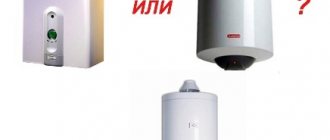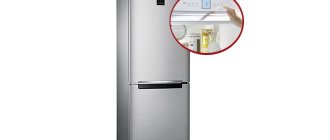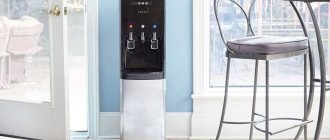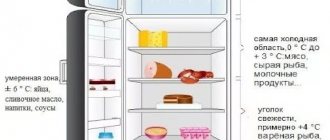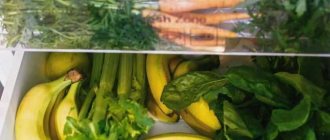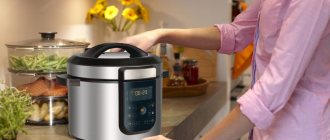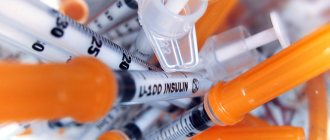Which cooling is BETTER, compressor or electronic?
Compressor cooling is much more productive than electronic cooling. In numbers:
- compressor cools down to 7o C,
- electronic up to 15o C
Attention, the electronic cooling unit does not work at air temperatures above 30 degrees; in hot summer weather its effectiveness is reduced to zero. The service life of compressor units is much longer. The thermoelectric cooling unit is equipped with a fan and, if preventive cleaning and maintenance work is not carried out, it quickly fails.
How does it work to heat water in a cooler?
The modern market is represented by a wide variety of equipment for heating liquids, but most of them work on the same principle. The equipment consists of:
- Tank for storing hot liquid. As a rule, this is a capacity from 0.6 to 3 liters. A heat insulator is made, which allows you to keep the water warm longer, saving electricity.
- A heating element. Basically, its power ranges from 400 to 1200 W.
- Boards responsible for the performance of the equipment.
- Two temperature sensors. The lower one has an operating temperature of 70–86ºС, but the upper one has this indicator at the level of 92–96ºС.
When the heating function is activated, the equipment begins to work to warm it up. It heats up until the top sensor is activated. Then the device turns off, and the liquid will cool down little by little, but not less than to the response temperature of the second, lower sensor. Heating occurs in just 1–2 minutes, after which the system turns off and remains idle for about 10–20 minutes.
The more often you draw hot water, the sooner the next batch of water will heat up.
IMPORTANT. You should not turn on the equipment without the bottle installed, this will soon lead to the heating element becoming unusable. This breakdown is not a warranty case.
Please note that the service life of the equipment is also affected by the quality of the fluid used and the timeliness of performing special maintenance work.
The cooler is buzzing, what should I do?
Natural noise during operation is considered normal. Level the device on a flat surface. Make sure all legs of the cooler touch the floor at the same level.
Most coolers are equipped with a water cooling system: compressor or electronic, and these installations create a slight hum that rarely disturbs others. In a cooler with a compressor, the sound is made by the compressor turning on, but in an electronic system, the noise is caused by a small fan. In bottom-loading coolers, the pump that supplies water to the storage tank may make additional noise, but its activation is short-lived.
What is the turbo heating function?
In recent years, modern manufacturers of this equipment have begun to produce models that are additionally equipped with a “turbo heating” function. Consequently, the coolers received increased power. They are also equipped with an LCD display and a special button so that you can enable or disable the “turbo heating” function if necessary.
REFERENCE. Regular cooler models are equipped with heating elements with a power of 400 to 600 W, while advanced models received heating elements with a power of 700 W.
It's not a refrigerator, but it's cold
When the resistance of the temperature sensor (thermistor) drops below 33 kOhm, the semiconductor element and the cooling fan turn on.
From the cooling radiator (Fig. 4), on which the fan is installed, a coil goes into the water tank, which absorbs the cold emanating from the semiconductor element, and the water temperature drops.
In practice, this element and the fan can work for several hours in a row (especially in summer, when the ambient temperature is +25 ° C or more).
At other times of the year, as a rule, the cooler turns on automatically for a short time of 5-8 minutes.
As the water in the tank cools, the resistance of the thermistor increases. In table Figure 1 shows the resistance values of the thermistor MMT-1, MMT-4 (designation on the NTC board) at different temperatures. These parameters were established through the author's experiment.
Table 1. Dependence of the resistance of the standard thermistor on temperature
| Temperature, °C | NTC resistance , kOhm | Cooling time to +5° C, min |
| Room regular +22 | 11,8 | 8 |
| Hot summer +25 | 10 | 12 |
| Hot summer +30 | 8,2 | 25 |
| Chilled tank +5 | 33,3 | — |
Thus, the cooler automatically turns off when the thermistor reaches a resistance of 33.3 kOhm.
It is clear that in the hot summer, for hot office guys, the water temperature of +5° C may not be low enough. So, we will have to work on further cooling the water.
Rice. 5. View of the printed circuit board of the cooler temperature monitoring and control device
There are no “manual” adjustments on the board.
It would be possible to change the resistance values in the voltage divider (in the comparator arms), but, in my opinion, this path is irrational and expensive.
Option one
I recommend this as the easiest way to cooling.
Thermistor connection locations are indicated by red lines. Nearby, a circle indicates the location for connecting an additional resistor (marked on the board as RNTC, but not connected).
In order for the cooler to work longer, even after passing the +5° C threshold, it is necessary to replace the MMT-4 resistor (designated NTC) with another one: with a resistance (at room temperature) not 12 kOhm, but slightly lower - 8.2 kOhm or at least 10 kOhm.
Then, when the temperature reaches +5° C, the resistance of the thermistor will increase to 27.7 kOhm and water cooling will continue (this has been established experimentally) - until the moment when the resistance of the thermistor reaches the range of 32-34 kOhm. (there are different values as a result of the experiment). The water temperature at this moment will drop to +1° C. All that remains is to place a glass in the cooler and shudder...
Improvements to coolers: providing above-planned cold!
The modification applies to models: YLR0.7-5-10T, YLR0.7-5-70T, YLR0.7-6-718A, YLR0.7-6-801A, YLR0.7-6-56A, YLR0.7-6 -59V, YLR0.7-6-63A, YLR0.7-6-758AD and YLR0.7-5-36TD. If heating the water in the cooler to 95°C is quite sufficient for coffee and tea, then it is quite possible to work on cooling it in the summer heat below +5°C.
As you know, water in coolers most often has electronic cooling, which operates based on the “Peltier effect”. Back in the 19th century, a French physicist discovered an amazing phenomenon: if direct current flows through a chain of conductors, the junctions cool down.
At the everyday level, we now use the “Peltier effect” thanks to the research of Academician Ioffe and new semiconductor alloys. The water in the cooler’s special tank is cooled by a thermoelectric module: direct current passes through a special radiator, in which the temperature quickly drops and the drinking water becomes ice-cold.
Rice. 3. Cooler with the back cover removed
In Fig. 3 you can see the connection of heating and cooling elements, water tanks and some temperature sensors.
In more detail, the principle of water cooling is as follows: the cooler has a flat-shaped semiconductor element installed on a cooling radiator with an area of 200 cm². A fan is attached to the radiator for additional cooling.
On the left side of Fig. 4 the fan, radiator and wires leading to the semiconductor element are clearly visible.
Rice. 4. View of the condensation device
The current consumption of this element is 4 A (therefore, the cooler requires a powerful power source) at a voltage of 12 ± 1 V DC. Fan current consumption is 0.19 A at the same supply voltage.
The temperature sensor of the cooled liquid is a thermistor in a metal-glass case of type MMT-4, installed in the reservoir closer to the front panel of the cooler.
The sensor is connected to the electronic board (on the right in Fig. 4) to the NTC connector.
The fan and heating element are also connected by appropriate connectors to the electronic control board. The cross-section of the connecting wires (red and black) to the heating element is at least 2 mm.
To what temperature does it heat water?
Floor coolers differ in technical characteristics, according to:
- productivity 4, 5, 6, 8 l/hour;
- power 0.42; 0.5; 0.6; 0.65; 1; 1.2 kW;
- temperature (water heats up to ≤90, 92, 94, 95 C°).
The maximum threshold to which the coolers heat water is 99°C (in the most expensive models).
Tabletop varieties have a capacity of 4 and 5 l/hour and maximum heating degrees of +87...+95. Power in the range of 0.42-1 kW.
To prepare most types of tea and coffee, you do not need to boil water, so the heating threshold for which the coolers are designed is quite sufficient for preparation. This has an additional advantage - the drink will not be scalding hot (it will be ready for drinking almost immediately).
What is the minimum temperature water can be?
Regarding cold water. The temperature depends on the type of cooling: electronic or compressor. In the first option, cooling is performed by fans up to +10...15°C. In the second there is a compressor (the temperature maintained in the cold water tank is +5°C, which is why it is less popular).
At what temperature in the cooler (in the heating tank) automatic heating turns on depends on the factory-set minimum threshold of +68...+85 °C (there are also models with custom settings).
Is it tasty to drink tea or coffee brewed with water from the cooler?
Is it advisable to buy a cooler for the office if it heats the water not to 100 degrees, which is the boiling point, but to 96? Do tea, coffee and other drinks taste good? It is interesting that even in a just boiled kettle the water temperature does not exceed 96 degrees, so in this sense the cooler and the electric kettle are absolutely the same. In addition, steep boiling water is not required to brew tea or coffee. To reveal and emphasize the taste of the drink, just pour hot water at a temperature of 96 degrees into the brew.
Which cooler model is best to buy for the office? Consultants will answer your questions and help with your choice.
I'll put it on the table to drink some water
Attention ! The cooler cannot be used without water: it does not have protection or a tank fill sensor. If you plug an empty cooler into a 220 V network, the heating elements will burn out. The coolers are adapted for a regular 220 V network and have a powerful switching power supply. During heating, the cooler consumes about 550 W of power, and during cooling - 50 W.
There are three LED indicators on the front panel of the cooler - red, yellow and green (some models have only red and green).
The red indicator turns off automatically when the hot water temperature rises to 95° C. The cooler switches to temperature maintenance mode: control and periodic heating of the hot water container occurs automatically using an electronic controller.
When the water temperature drops below +80°C, the red indicator turns on again and water heating begins.
The green indicator (cooling condenser) automatically turns off when the water temperature in the cooling tank drops to +5° C.
If there is no need for hot or cold water, the unnecessary function can be disabled with a key switch on the rear panel of the cooler (Fig. 2).
Rice. 2. View of the rear panel of the cooler
As can be seen from Fig. 2 (top) on the cooler body there are red and green switches that automatically maintain the temperature of hot and cold water.
The cold water reservoir is made of food-grade plastic. Purified water, distilled or mineral water is used as a source.
When moving or transporting the cooler, it is necessary to disconnect the water tank (which has a nipple-type valve) and drain the remaining water from both tanks through the drain pipes located at the bottom of the case. Install the cooler only in a vertical position. As a last resort, the angle of inclination cannot exceed 45°.
It is necessary to constantly ensure that the water level in the water jar is at least 1 liter. Then they put in a new filled jar.
Is it possible to make tea?
You can brew tea using a cooler (although its maximum temperature is 95 degrees).
The foam that appears is stirred with a spoon, it quickly disappears.
itself will be successful. Therefore, the cooler is suitable for these purposes.
Reference! The quality of tea does not differ in taste if purified water is used to prepare it.
